- svg]:stroke-accent-900">

How to organize your browser tabs vertically—and why you should do it
By David Nield
Posted on Sep 27, 2022 2:00 PM EDT
4 minute read
We all like to have our programs set up just the way we like, and browsers are no exception. You can do aesthetic changes, like moving the icons of your favorite extensions for easier reach, or changing the backdrop of new blank tabs.
But you can also revolutionize the way you use the program by changing how tabs propagate during a browsing session. You can rearrange and pin them, of course, but you can also shift their position down to the side of your screen rather than along the top. The option just made its way back to the latest edition of Safari on macOS, but other browsers have vertical tabs, too.
While it might not sound like a major change, it can make a big difference to your browsing experience. You’ll be able to reach tabs on the side more easily and scan them more quickly, (especially if you’re on an ultra-wide monitor ), and web pages will benefit from more vertical space on your screen. It’s an option that’s well worth trying to see if it works for you.
How to activate sidebar tabs on Safari
The most recent version of Safari brings vertical tabs back—the feature was previously available but hasn’t been in recent years. The tabs appear by default in the sidebar, which you can make visible by clicking the Show sidebar icon in the toolbar or by opening the View menu and then choosing Show Sidebar .
[Related: 5 browser extensions that will keep you from drowning in tabs ]
As you browse you’ll see your tabs show up on the left of the screen, as well as any tab groups you’ve saved (just click on any of them to expand them). Click and drag on a tab to change its position on the list, or to drag it to an existing tab group. You can also right-click on a tab title to access all the standard tab options in a pop-up menu, including Close Tab , Duplicate Tab , and Copy Link .
How to get vertical tabs on Chrome
Google Chrome doesn’t support vertical tabs natively, so you’ll need the help of a third-party extension. The perfectly named Vertical Tabs is the best option we found and it won’t cost you anything. Simply download the add-on and then click the orange Vertical Tabs icon in the Chrome toolbar to activate it.
You can drag and drop tabs to reorder them, refresh and close tabs using the buttons to the right, and search your tabs using the box at the top. Right-click on a tab for options such as Pin and Mute this Tab , and click the cog icon at the top to get to the extension options. From there, you can choose which side of the screen the tabs are on, and pick between dark and light themes.
How to bring vertical tabs to Firefox
Just like with Chrome, if you want to get vertical tabs in Firefox, you’ll need the help of a third-party extension. And also just like with Google’s browser, the solution is an add-on called Vertical Tabs , though it’s not the same one we mentioned above. This tool is a fine and free option that’s utterly simple to use. It allows you to display or hide the sidebar by clicking on the Vertical Tabs icon that pops up on the Firefox toolbar once you download the extension. You can also click on the cog icon above the vertical tabs to access the tool’s settings, where you’ll be able to choose a theme if you want to, among other options.
You can change the position of tabs by dragging and dropping them in the sidebar, and close them with a click on the X icons to the right. Right-click on any of the tabs for all the key functions you’re going to need while browsing, such as Reload Tab , Close Tab , and Mute Tab .
How to turn on vertical tabs on Edge
Microsoft has added vertical tabs as a native feature to its Edge browser, so you’ll need no extensions if you use this app to surf the web. To activate them, click the Tab Actions Menu button, which is up in the top left corner of the browser and looks like a square with two small rectangles around it, indicating a browser interface. Then, choose Turn On Vertical Tabs . The tab headers will then make the switch from the top to the left-hand edge of the interface.
As always, you can drag and drop tabs to change their order, close them with a click on the X icons to the right, and bring up a host of other options—from refreshing tabs to bringing back the last tab you closed—by right-clicking on a tab header. Click the Tab Actions Menu again to turn off vertical tabs or to search through them.
How to get vertical tabs on Opera
If Opera is your browser of choice then you’re going to need to install a free extension called, appropriately enough, Vertical Tabs —again, not the same one available for Chrome or Firefox. Once you’ve installed it, you’ll see a new icon on the toolbar on the left, which looks like four horizontal lines on top of each other. Click on it to show or hide the vertical tab list. You can also click the pin icon on the actual vertical tabs list so that it remains visible.
[Related: Twelve ways to make your new browser tabs more exciting ]
You can reorder tabs by dragging and dropping them, and if you hover over a tab title you can close it by clicking the X on the right. Around the side of the vertical tabs panel you’ll see buttons for pinning and grouping tabs, searching through tabs, and all the other key functions you’re going to need.
Latest in Tech Hacks
5 places to listen to free audiobooks 5 places to listen to free audiobooks, how to customize screensavers on your tv how to customize screensavers on your tv.

How To Split Screen Two Safari Tabs On Mac
Are you looking for an easy way to view two Safari tabs at once on your Mac? If so, you’re in luck! With Apple’s Split View feature, you can easily open two Safari tabs side-by-side.
Split View is a great way to multitask with multiple windows and apps on your Mac. It’s especially useful when you need to compare two different web pages or research topics simultaneously. Here’s how to split screen two Safari tabs between your Mac:
1. Open the first Safari tab that you want to view in Split View.
2. Press Command + F3 or Control +F3 to bring up Mission Control and select the second Safari tab that you want to view in Split View.
3. Drag the second tab onto the first tab, which will automatically open it in Split View mode as long as both windows are compatible with this feature.
4. You can then adjust the size of each window by dragging the separator bar between them either up or down, depending on how much space you want each window to occupy.
5. To exit out of Split View mode, drag both windows away from one another until they are no longer connected, and then click off of them onto your desktop background or an open app window.
And just like that, you now know how to split screen two Safari tabs between your Mac! This feature is incredibly useful for those who need a convenient way to compare two different web pages or research topics at once without having multiple windows cluttering up their screen. Give it a try today and maximize your productivity!

Splitting Screen with Two Safari Tabs
Yes, you can split screen two Safari tabs. To do this, open the Safari browser and tap the Multitasking button at the top of the screen. Next, tap the Split View button. This will open a second Safari window side by side with your original tab, allowing you to view both tabs simultaneously.
Splitting a Mac Screen into Two
Yes, you can split your Mac screen into two. To do this, first, enter full-screen mode by pressing Control + Command + F. Then hit F3 to open Mission Control and drag another app onto the app you already have in full-screen. Click back into the newly tiled apps and you’ll be in Split View. This allows you to have two applications open on the same screen and easily switch between them.
Viewing Two Tabs Simultaneously
To view two tabs at once, you can use a split-screen feature in your web browser. In most browsers, you can do this by dragging the tab to the side of your screen and releasing it when it is the size you want. This will create two separate windows with different tabs open in each, allowing you to view both at the same time. Alternatively, if you have multiple monitors connected, you can choose to extend your desktop across them and open a different tab on each monitor.
In conclusion, Safari tabs on Mac allow you to have multiple browser windows open at once. With the Multitasking menu and Split View, you can easily manage your tabs and switch between them quickly. You can also use control + command + F to enter full-screen mode and F3 to bring up Mission Control to better organize your tabs. With Safari on Mac, multitasking is a breeze!
Related posts:
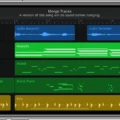
James Walker
How to use Safari Tab Groups
If you’re a safari user, tab groups can help you keep your life organized and your desktop clean..
By Monica Chin , a senior reviewer covering laptops and other gadgets. Monica was a writer for Tom's Guide and Business Insider before joining The Verge in 2020.
Share this story
:format(webp)/cdn.vox-cdn.com/uploads/chorus_asset/file/23952314/HT016_macOS_0008.jpg)
If you’re using Safari but you’re not using Tab Groups, well, it’s time to change that.
Tab Groups, as the name implies, allows you to group a selection of tabs together and essentially set them aside for future use. For example, if you have a bunch of tabs you use for work and a bunch of tabs you use after work, you can cordon these tabs off into batches so that they don’t get in each other’s way. You can use your work tabs at work and, when you’re finished, swap them for your “after work” tabs with just one click.
- How to use Microsoft Edge’s new tab groups feature
You might also have different Tab Groups for different assignments at work or different school projects. Folks who share a computer might have different Tab Groups for each user. The possibilities are endless.
Here’s how to create a tab group in Safari.
How to create Safari Tab Groups on macOS
There are a couple of ways to do this. The easiest method is to make a group out of whatever tabs you currently have open. If you’re about to close Safari but think you might need to pick up where you left off when you open it later, throwing your tabs into a group can give you some peace of mind.
You can also create a tab group from scratch if there is a batch of tabs you think you might want to use later. This is a bit more time-consuming but will allow you to be more selective about which tabs to include.
:format(webp)/cdn.vox-cdn.com/uploads/chorus_asset/file/24808944/Screenshot_2023_07_25_at_1.41.42_PM.png)
To create a tab group from existing tabs
- In Safari, click the down arrow in the toolbar. (It’s on the left side, next to the button that opens the sidebar.)
- Pick New Tab Group With [X] Tabs .
- In the left column, look for the Tab Group subhead. Name your tab group, then press Enter.
:format(webp)/cdn.vox-cdn.com/uploads/chorus_asset/file/24808951/Screenshot_2023_07_25_at_1.43.19_PM.png)
To create a tab group from scratch
- Click the down arrow in the toolbar. (It’s next to the button that opens the sidebar.)
- Pick New Empty Tab Group .
- Name your tab group, then press enter.
- Right-click a tab you want to add to the group, click Move to Tab Group , and select the tab group you want. Alternatively, you can click and drag the tab to your group on the left side.
To open your new tab group
- Click on that down arrow again.
- Click on the tab group you want.
Once you’ve got a group up and running, it’s not set in stone. You can adjust the makeup of a given tab group by clicking the arrow to its right in the sidebar’s tab group list. Right-click any tab that comes up, and you’ll have the option to remove it from the group, remove all tabs that aren’t it from the group, or move it to a different group,
You can also click the three dots just next to the arrow if you want to rename, delete, or share the group, along with other options.
How to create Safari Tab Groups on iOS
Tab Groups can sync between iOS and macOS devices, so if you create one on your Mac computer, you can still access it on your iPhone. Nevertheless, if it’s more convenient for you to create these from the Safari app on iOS, you can certainly do so.
- In the Safari app, click the tabs button on the bottom right. (It’s the one with two squares.)
- Press and hold a tab you want to add, then pick Move to Tab Group .
- Select New Tab Group .
- Name your new group.
Uber will pay you $1,000 to ditch your car for five weeks
What scotus just did to broadband, the right to repair, the environment, and more, here comes a meta ray-bans challenger with chatgpt-4o and a camera, more youtube premium plans are coming, microsoft’s ai boss thinks it’s perfectly ok to steal content if it’s on the open web.
More from How to
:format(webp)/cdn.vox-cdn.com/uploads/chorus_asset/file/25287814/HT012_Google_Keep.png)
How to make the most of Google Keep
:format(webp)/cdn.vox-cdn.com/uploads/chorus_asset/file/23324425/VRG_ILLO_5090_The_best_Fitbit_for_your_fitness_and_health.jpg)
The best Fitbits for your fitness and health
:format(webp)/cdn.vox-cdn.com/uploads/chorus_asset/file/23952309/HT016_macOS_0003.jpg)
How to uninstall apps in macOS
:format(webp)/cdn.vox-cdn.com/uploads/chorus_asset/file/24008212/HT015_S_Haddad_ios_iphone_14_02.jpg)
How to check which apps are using the most data on an iPhone
A Roundup of Vertical Tab Support in Mac Web Browsers
One of the features that attracted me to the new Web browser Arc was the way it organizes tabs vertically in a left-hand sidebar (see “ Arc Will Change the Way You Work on the Web ,” 1 May 2023). Before Arc, I knew there were extensions for Google Chrome and add-ons for Firefox, but every time I played with them, they were too awkward to use for real. I knew that Microsoft Edge had added vertical tabs at some point, but the only reason I even have Edge on my Mac was so I could try Bing’s AI feature. My real blind spot was Safari, which added vertical tabs some time ago but failed to communicate that fact in the interface in a way I noticed. I’m not alone—when I mentioned this fact to Tonya, who uses Safari as one of her main browsers, she was equally unaware.
But now that I’ve become a complete convert to the wonders of vertical tabs, I’m seeing them everywhere. Or perhaps the industry has hit some sort of intersection between users clamoring for the option and browser makers gaining the gumption to brainstorm better interfaces. Whatever the reason, if you’re not using vertical tabs now, I’d encourage you to try them, either in your current browser or one of the newcomers mentioned below.
What makes Arc’s vertical tabs so compelling for me is how I can create, organize, and rename pinned tabs and then collect them into workspaces, making all the pages I regularly use just a click or two away. Of these other browsers, Vivaldi comes closest to Arc, followed by SigmaOS, though neither has encouraged me to switch. Of the major browsers, Safari stands out because it lets you create tab groups and pin tabs within those groups. All the rest of the browsers support tab groups and pinned tabs, but as soon as you pin a tab, it leaves its group and shrinks from an icon with a name to just a tiny icon. Frustrating, but perhaps these other browser makers will eventually come to their senses and keep pinned tabs in their groups.
Previously my favorite browser, thanks to its privacy focus and helpful features, Brave has just added vertical tabs in version 1.52. To turn them on, navigate to brave://settings/appearance and select Use Vertical Tabs. Once that’s done, your tabs appear in a left-hand sidebar instead of at the top of the screen.

It’s easy to create tab groups by selecting multiple tabs, Control-clicking them, and choosing Add Tabs to Group > New Group. To populate my tab groups, I Command-clicked my bookmark folders for TidBITS and FLRC to open all their tabs simultaneously, then combined them into tab groups.
Unfortunately, pinning tabs in Brave causes them to jump to the top of the vertical tab sidebar and display as tiny unnamed icons, rendering the feature useless for multiple pages on the same site. Without better pinning, if you navigate within a standard tab in one of Brave’s tab groups, the only way of reverting to the tab’s original URL is by navigating back within it. Brave does remember the tab’s history, even through restarts, but it’s still clumsy.
Although Brave’s implementation of vertical tabs doesn’t make me want to switch back from Arc, I prefer it to the old top-mounted tab bar and plan to keep it active.
Mozilla hasn’t yet seen fit to support vertical tabs within Firefox , but the Vertical Tabs Reloaded add-on gets you part of the way there. It doesn’t replace Firefox’s top-mounted tab bar (and there’s no way I can find to turn that off), so you’ll have to put up with that duplication. Aside from that, Vertical Tabs Reloaded does a decent job of providing a sidebar of your current tabs.
Although Firefox supports pinned tabs, both it and Vertical Tabs Reloaded lack the concept of tab groups, so there’s no way to organize your tabs in the sidebar. Like other browsers, pinned tabs appear only as tiny icons at the top of the sidebar in Vertical Tabs Reloaded, rendering even a manual organization of tabs somewhat pointless.
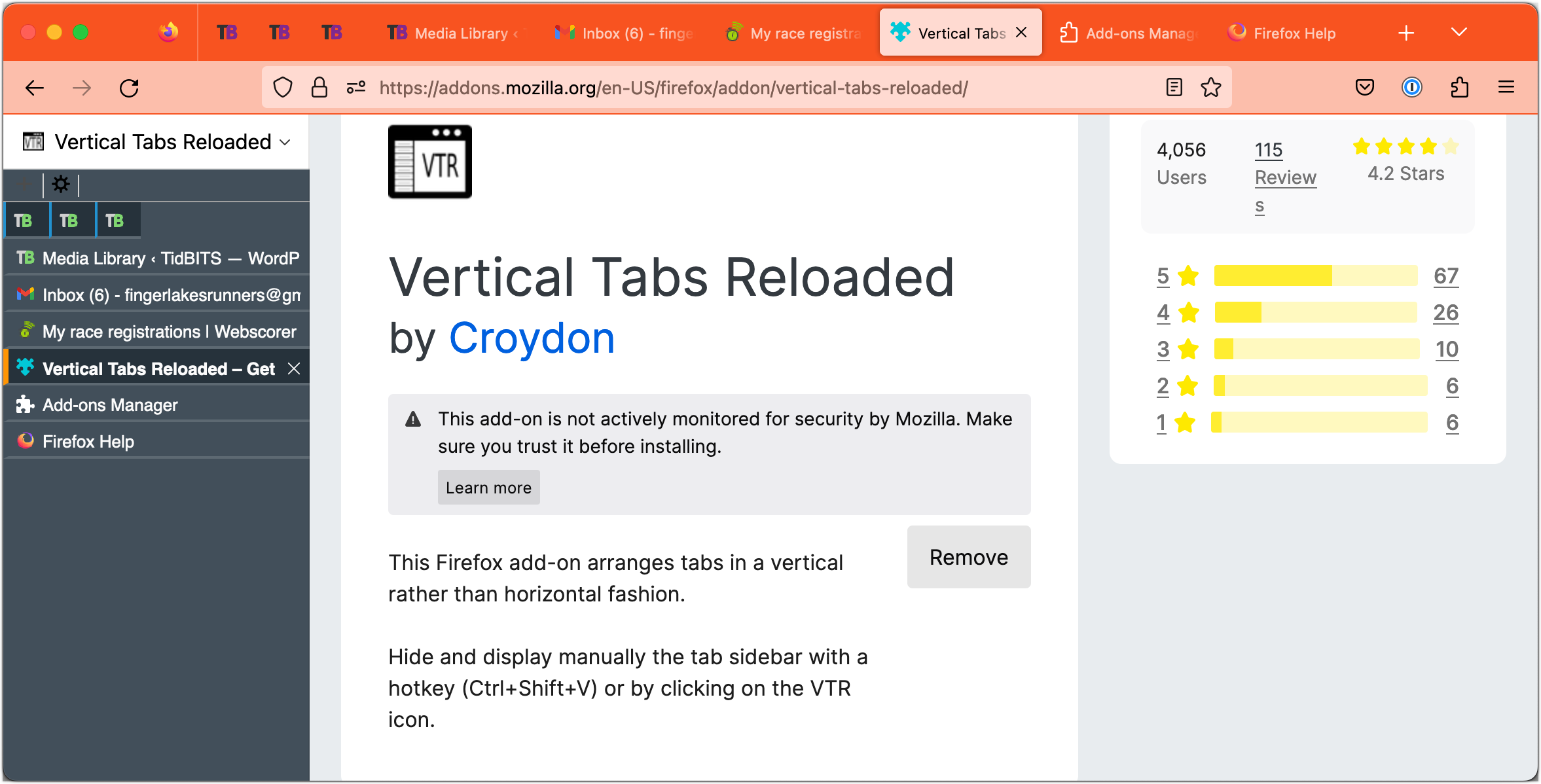
While Vertical Tabs Reloaded doesn’t come close to replicating the capabilities of Arc, it was worth leaving active in Firefox for my minimal testing and troubleshooting activities.
Google Chrome
I’m surprised that Google hasn’t added vertical tabs to Chrome yet, given that Brave and Microsoft Edge—both based on Chrome—have. Nevertheless, the only way to get vertical tabs in Chrome is with an extension like Vertical Tabs . As with the Vertical Tabs Reloaded add-on for Firefox, Vertical Tabs provides an additional sidebar containing tabs along with the usual top-mounted tab bar, which can’t easily be hidden.
Vertical Tabs doesn’t acknowledge Chrome’s tabbed groups, and while it does support pinned tabs, Chrome separates all pinned tabs from their tab groups on the left side of the tab bar, and Vertical Tabs mimics that by placing them at the top of its sidebar.
Making it even fussier to use, Vertical Tabs doesn’t display its sidebar when you open a new tab, and it takes a second to appear after loading whatever page is in that tab, causing content to slide right. Plus, as you can see with the TidBITS site below, which should be centered in the window, Vertical Tabs sometimes confuses sites as to the page width.

As with previous times I’ve tested it (or extensions like it), I found Vertical Tabs more trouble than it was worth and turned it off after capturing this screenshot.
Microsoft Edge
The vertical tab implementation in Microsoft Edge is similar to Brave’s from a functionality standpoint. You turn it on by navigating to edge://settings/appearance and clicking the Turn On button next to “Show vertical tabs for all current browser windows.” That’s an odd interface decision; why not use a toggle switch like the controls above it?
Edge does a slightly better job than Brave in visually connecting the contents of tab groups in the sidebar, but it has the same problem with pinned tabs moving from their group to the top of the sidebar.
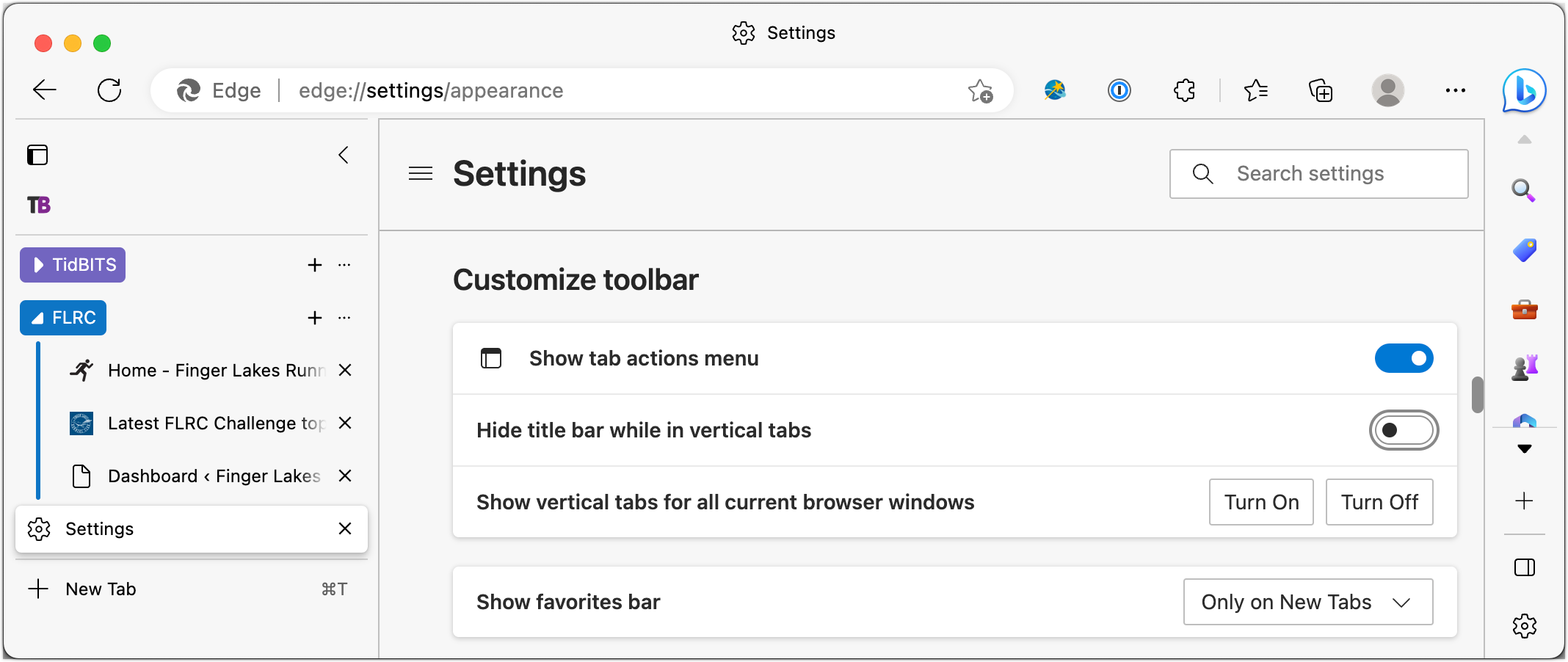
As with Brave, I’m not tempted to use Edge as my default browser, but I’ll stick with its vertical tab approach whenever I use it.
I haven’t used Opera in years, and while it continues in active development, even getting it set up enough to take a screenshot felt awkward. That quick impression aside, there is a Vertical Tabs extension available for Opera, and although it hasn’t been updated for over 4 years, it still seems to work.
It’s not particularly easy to set up, but once you install it and activate it from Opera’s sidebar (something that’s also not obvious), it does a decent job of letting you create, group, and access tabs. Although it supports pinned tabs, they’re removed from their groups and displayed as tiny icons like in many other browsers. Be sure to click the pin icon in the upper-right corner of the Vertical Tabs interface to keep it onscreen.
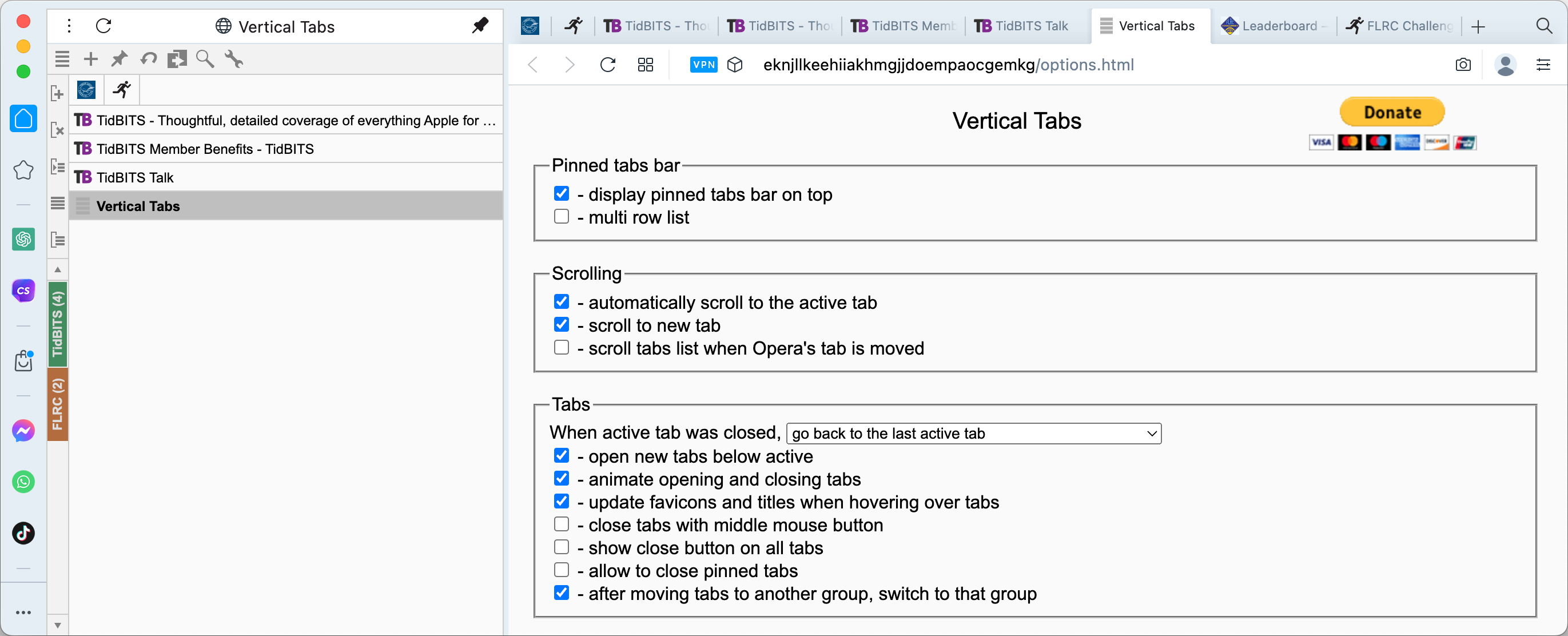
If you’re already a diehard Opera user, the Vertical Tabs extension is a boon, but it’s no reason to switch to Opera from any other browser.
I hadn’t been aware of the beta of the new Orion browser until Kagi, the company behind it, contacted me after my Arc review. (And yes, this Kagi is an entirely different company from the Kagi digital commerce company of yesteryear; the new Kagi purchased the kagi.com domain from the old one. See “ Kagi Shuts Down After Falling Prey to Fraud ,” 4 August 2016.)
Orion is extremely interesting. It’s built on top of WebKit, like Safari, but it also supports both Chrome and Firefox extensions, albeit with some caveats at the moment. The developers have put significant effort into making it fast and lightweight, and it boasts an impressive set of privacy options, with built-in ad and tracker blocking.
For this article, however, I want to focus on Orion’s vertical, tree-style tabs, which you can turn on by choosing View > Show Vertical Tabs Sidebar. What sets Orion apart is that it’s the first browser I’ve discussed so far that separates its tab groups—which it calls Named Windows—from one another. A pop-up menu at the top of the sidebar lets you switch between named windows, and Orion remembers their contents between restarts. Separating named windows in this way also makes pinned tabs more useful. Yes, they still appear at the top of the sidebar as nothing more than a tiny icon, but at least they’re specific to their named window rather than being all lumped together.
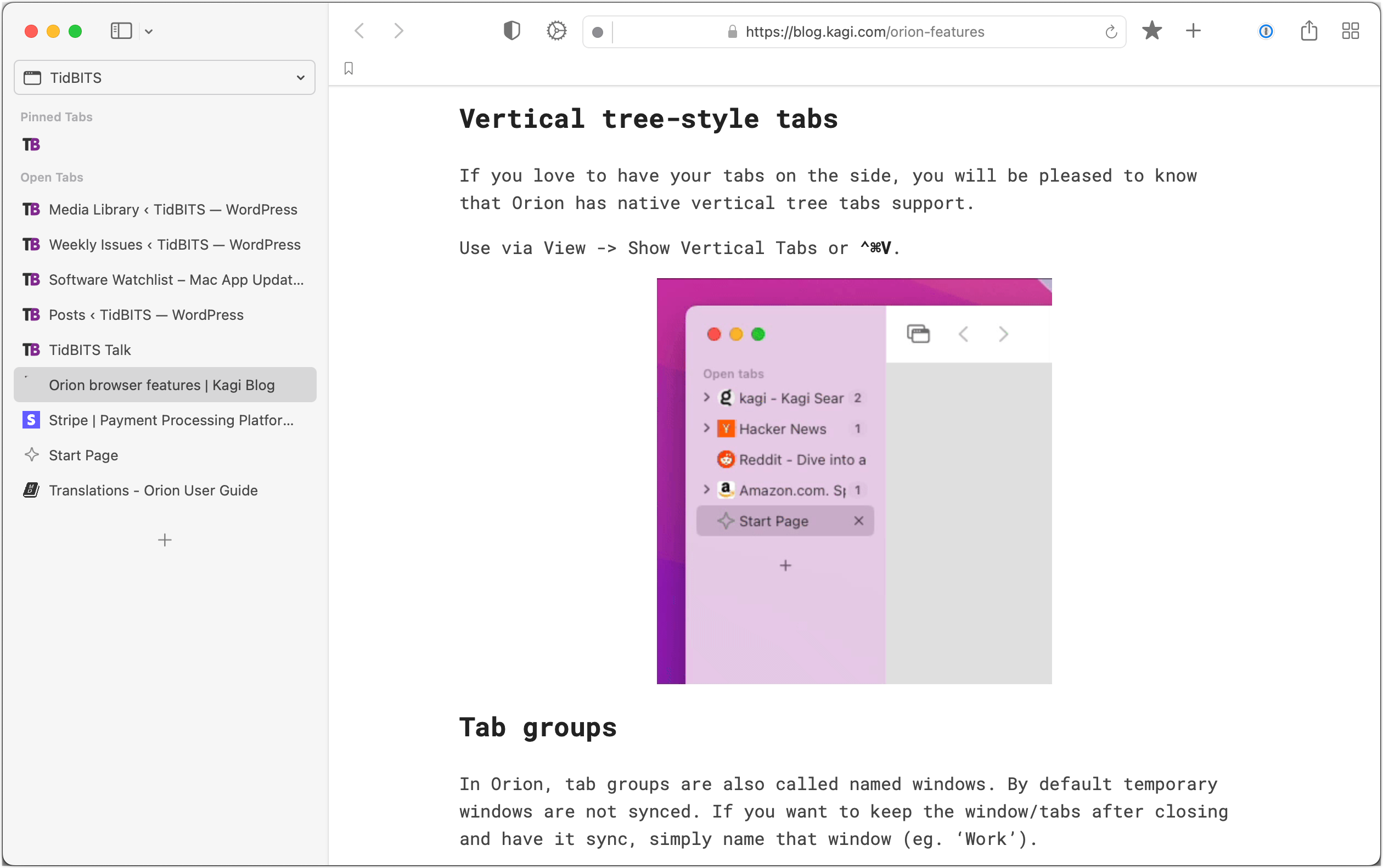
Orion even has a visual tab switcher like Arc, although its beta status was confirmed when I hit a bug that prevented the tab switcher from appearing when I moved Orion to another screen. Still, if you’re intrigued by independent Web browsers, Orion is worth a close look.
Safari needs no introduction, but you may not be aware that it has the most complete vertical tab implementation of any of the major browsers. You won’t find the term used anywhere in its interface or Apple’s documentation, but when you reveal Safari’s sidebar, you’ll see that tabs and tab groups appear there. (Part of the confusion is that the sidebar can also show bookmarks, your reading list, Shared with You links, and iCloud Tabs.) You may have to do a little clicking around to get your tabs groups to look how you want, but the capabilities are solid once you do.
When you’re in a tab group, creating a new tab puts it in the same tab group, and if it’s a page you want to revisit regularly, you can Control-click it and choose Pin Tab. Pinned tabs display a pin icon to the right of their names—thank goodness they don’t shrink to tiny icons!—and they’re sticky. Closing the window associated with a pinned tab displays Safari’s Start page, so you can’t accidentally close them. Control-clicking and choosing Unpin Tab lets you close it, or you can choose Close Tab to unpin and remove it in one step. To rearrange your pinned tabs in an order that makes sense to you, drag them around. Alas, you can’t rename them. Happily, you can turn off the top-mounted tab bar by choosing View > Always Show Tab Bar.
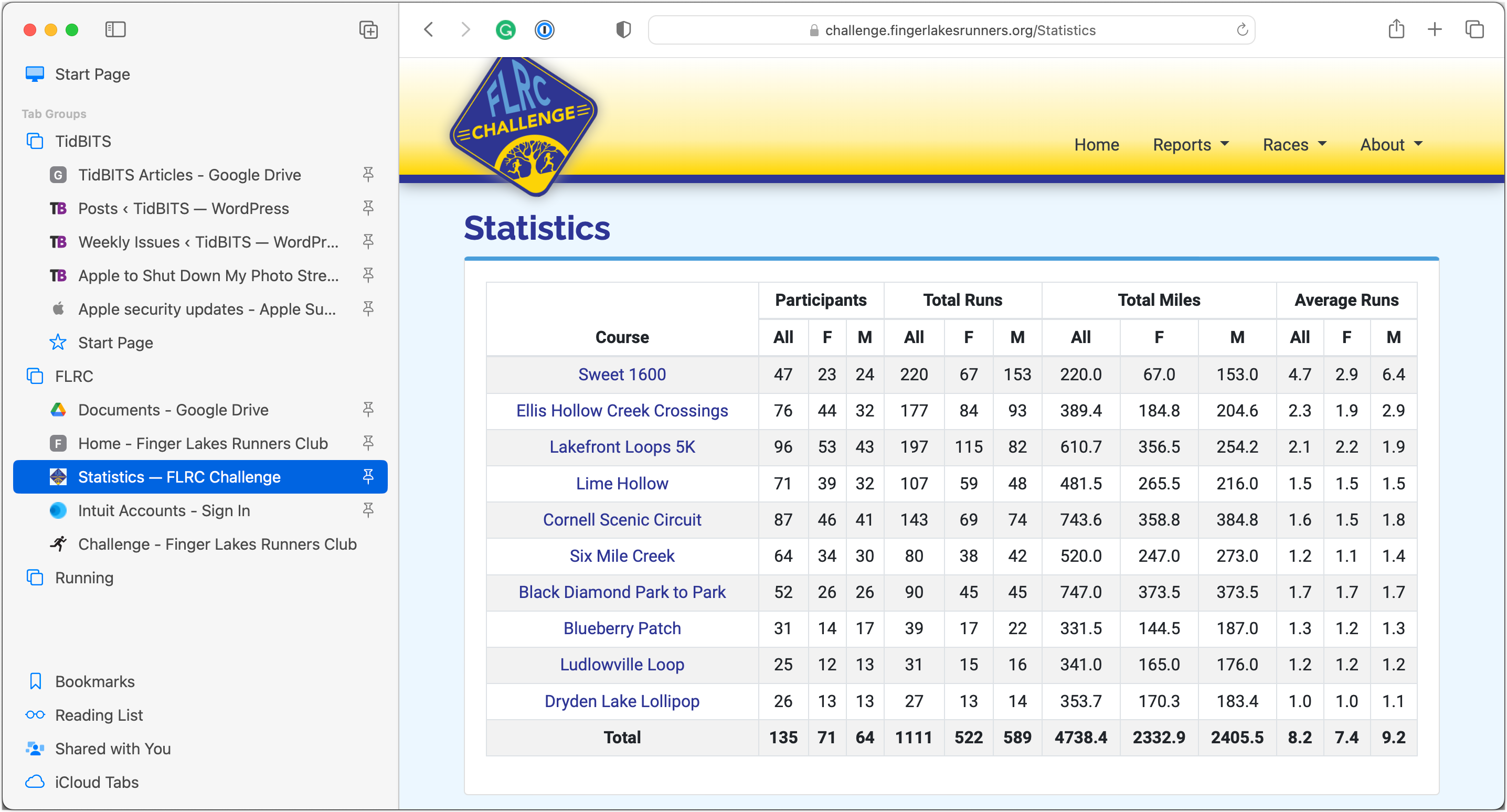
If you’re using Safari now, as I’m sure many of you are, I strongly encourage you to give vertical tabs a try and make liberal use of pinned tabs in tab groups. Apple did an excellent job with Safari, and if nothing else, its vertical tab support might encourage you to experiment with one of the newer browsers that has support for workspaces and additional interface refinements.
Like Arc (and Vivaldi, as you’ll see next), SigmaOS is a radical rethinking of the Web browser interface, including a switch to vertical tabs collected into proper workspaces. I haven’t used it enough for a serious critique, but I found it quite challenging to wrap my head around and generally funky. For instance, you “mark tabs as done” with D instead of closing them with Command-W, and the File and View menus contain only a single command each (Print and Enter Full Screen). SigmaOS is just odd, but at least you can customize the keyboard shortcuts to bring Command-W back into play.
But, as I said, SigmaOS does let you create workspaces containing related tabs, and you can “lock” any tab to do what seems to be the equivalent of pinning it. You can drag tabs around in the list to arrange them in your desired order, although you can’t rename them, like in Arc, so the list is always a bit hard to read. SigmaOS also supports split-screen views, can open external links in standalone windows, and can sync the contents of workspaces between Macs.

As with Arc and Vivaldi, becoming familiar with SigmaOS would take at least a few days, during which you’d need to create and populate workspaces, configure keyboard shortcuts, and more. If neither of the other two fits with how your brain works, give SigmaOS a try.
I’m embarrassed that I haven’t checked out Vivaldi before. It’s a mind-bendingly flexible Web browser that’s easily on par with Arc’s capabilities. Like Arc, it supports proper workspaces and displays tabs in a vertical sidebar, though you can also put them on the top, bottom, or right. You can pin as many tabs as you want, and they display like standard tabs rather than shrinking to useless little icons. It has a visual tab switcher and can sync your setup between devices.
As impressive as Vivaldi’s feature set is, it lacks Arc’s attention to interface detail. For instance, the sidebar picks up its color from the current site, so it’s purple in the screenshot below because it’s showing the TidBITS site. But when you move to any other site, the entire sidebar changes color, which is visually abrupt. You can switch to a Subtle theme that makes the sidebar gray for all sites, which is less glaring but still doesn’t compare to Arc’s clever approach of colorizing the sidebar differently for each workspace.
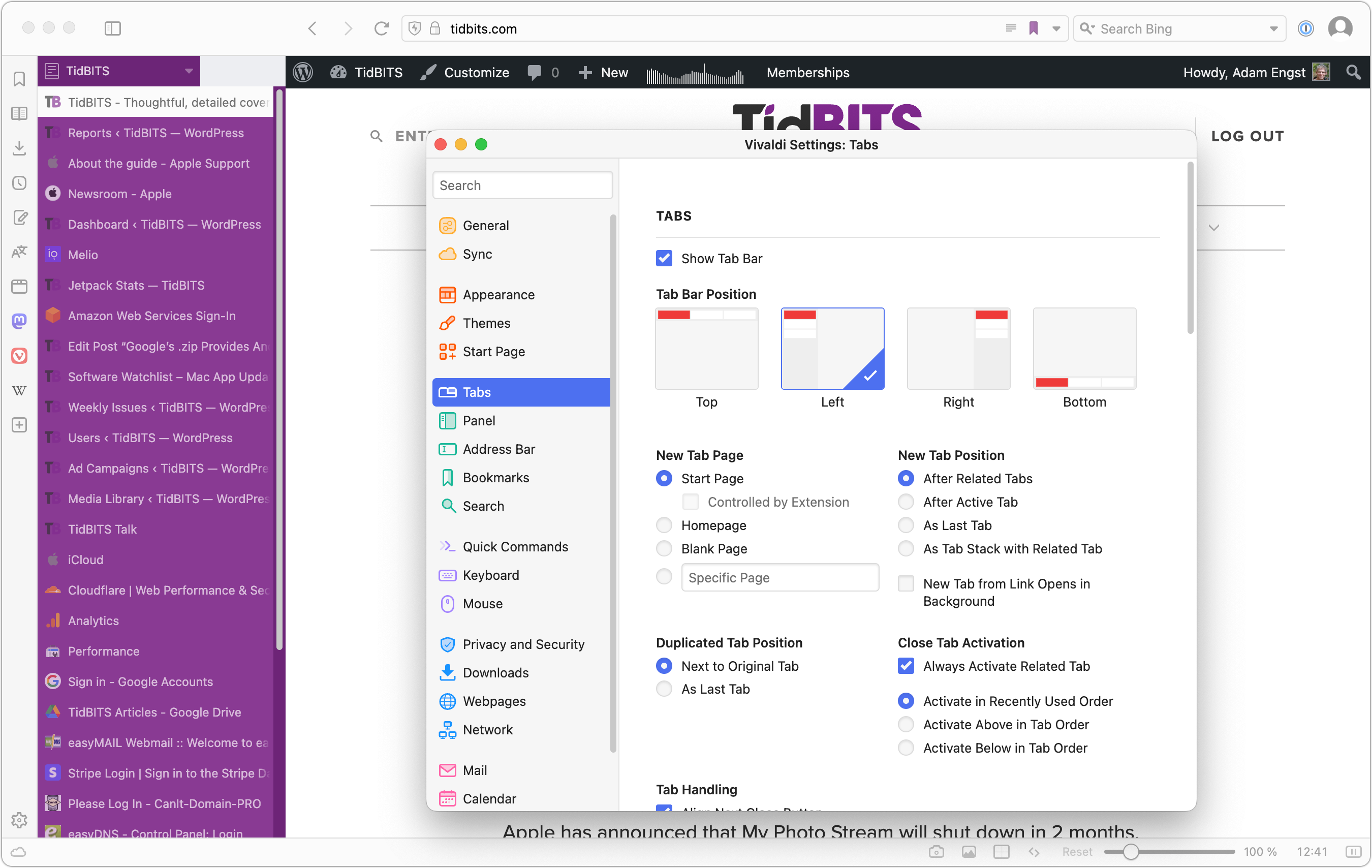
Similarly, although you can move pinned tabs within Vivaldi’s sidebar, you have to do it by Control-clicking and choosing Move Tab > Up/Down rather than just dragging. Nor can you drag a regular tab up into the pinned tab area to pin it; you must Control-click it, choose Pin Tab, and then move it. Configuring Vivaldi as you like would be tedious, and there’s no way to rename tabs, as in Arc, so you’re at the mercy of however the pages were named.
Nonetheless, If I weren’t already delighted with Arc, I would seriously consider a switch to Vivaldi right now—it’s that much better than the major browsers but doesn’t venture as far afield as SigmaOS.
In the end, those who seldom open lots of tabs and don’t spend hours per day in a Web browser may see vertical tabs as a distinction without a difference. But if you rely heavily on your browser—particularly if you prefer tabs to be represented by their names rather than just icons—I encourage you to experiment with the vertical tab options now available.
Subscribe today so you don’t miss any TidBITS articles!
Every week you’ll get tech tips, in-depth reviews, and insightful news analysis for discerning Apple users. For over 33 years, we’ve published professional, member-supported tech journalism that makes you smarter.
Registration confirmation will be emailed to you.
This site is protected by reCAPTCHA. The Google Privacy Policy and Terms of Service apply.
Comments About A Roundup of Vertical Tab Support in Mac Web Browsers
Notable replies.
Happily, you can turn off the top-mounted tab bar by choosing View > Always Show Tab Bar
On my Safari, that just hides it if I don’t have any tabs open. If I have tabs, even vertical ones, the horizontal bar appears and the “Always Show Tab Bar” is greyed out. I suspect I’m doing something wrong, but I can’t figure out what?
Huh! Now I’m seeing that too, and I don’t know what changed, nor can I hide those top tabs again. Clearly it worked before since I was able to get a screenshot and it’s still working in another one of my tab groups. Bug?
You can get rid of the tab bar by moving the tabs up to the toolbar by selecting the compact view in Safari>Settings>Tabs.
This is not a great solution if you have a lot of open tabs.
It seems like you can only disable/hide the tab bar if there’s one tab open. When you open even a second tab, it gets grayed out.
The tabs still exist in the tool bar so that’s not really a solution.
FireFox has several extensions that support vertical tabs. I used the “Tree Style Tab” until I switched to Safari’s tab groups. The “Tree Style Tab” allows you to organize the tabs hierarchically in the sidebar, thus simulating the grouping capabilities other browsers.
Ah, I understand now. The command becomes unavailable if you have more than one normal tab in the tab group. You can have all the pinned tabs you want and still hide the tab bar. That’s really odd—what difference does it make?
Hmm…supposedly this did exist on iPad Safari: iPadOS 16.4 Safari - No option to hide tab bar? | MacRumors Forums
Maybe you could do this on Mac Safari before and Apple changed/broke it? I can see why they might want to do that, since I could see people accidentally selecting it then get confused because “all of their tabs disappeared”…
Judging from the screen shots in the article, you lose more screen space with these vertical tabs than you do with a standard tab bar at the top.
Yes, that is my experience in Safari 13.1.2 with High Sierra (my iMac is maxed at that OS version).
Yes, as measured by raw pixels, but not in reality because most screens are much wider than they are tall. A sidebar of tabs is unlikely to take any space away from an average Web page, whereas the top-mounted tab bar sucks space from every Web page that requires scrolling.
Plus, screen real estate is worth spending to increase productivity, and being able to see a tab’s name is far more helpful than a tiny icon.
I, too, am quite happy with “Tree Style Tab” in Firefox.
I agree with both of those points. Screens are quite wide; I just use a wider browser window with vertical tabs. Also, I use vertical tabs only in the browser I primarily use for research and work, where I might have 10 or 20 sites open and horizontal tabs become useless. Adam mentioned that Firefox add-ons don’t replace the horizontal tabs, but I just noticed that they aren’t there with Tree Style Tabs.
Exactly, which is why it’s so frustrating that the top-mounted tab bar insists on staying open even with the vertical tabs active. I could set Safari to compact view so that it sprinkled the top tabs in the address bar but that looks so cluttered.
It seems that I can’t try it on Safari 13.1.2 since that is the last version that will run on my iMac. I usually don’t have that many open anyway so I always see title of each tab in the bar.
In Mac Safari, there doesn’t seem to be a way to have the sidebar tabs lists always expanded?
I mean, I can expand the list, and then it stays expanded, but then on quit/restart, they all collapse again.
That’s what I was getting at when I wrote:
You may have to do a little clicking around to get your tabs groups to look how you want, but the capabilities are solid once you do.
I tried using Safari with vertical tabs for secondary research tabs while writing in Arc yesterday, and while it worked, it drove me somewhat batty. Much easier to have a second Arc window so I can see both things at once.
After reading this roundup article, I kept on thinking that Firefox had this capability as well, but I couldn’t find it. Well after quite a bit of web searching, I found what I was thinking of.
Firefox 4 (March 2011) introduced a feature called “Panorama” (aka “TabCandy”). This feature lets you group tabs into application-spaces which can be quickly opened and closed and switched between.
The feature was removed from Firerfox in version 45 (March 2016), apparently due to lack of interest. It’s a bit ironic that this is a feature that people might want to use today. At least there are third-party add-ons that provide similar capabilities.
- Article about TabCandy which became Panorama. (Linked from FF 4 release notes)
- ArsTechnica article about FF4b4 mentioning Panorama. Panorama image that is supposed to have been in-lined with the article.
- Article about Panorama’s removal (linked from FF45 release notes)
- A better article about Panorama from a site promoting a similar feature as a commercial product.
- Panorama Tab Groups . An add-on (last updated in 2020) that claims to put back the Panorama feature.
You forgot about the progenitor of vertical tabs, OmniWeb (OW). If it wasn’t the first, it was one of the earliest.
You would have to ask Ken Case when he implemented the feature. I’m thinking around 10 or more years ago as I’m pretty certain I was using it on my G4 PowerBook.
If you want to check it out, it’s here: Omni Labs — OmniDiskSweeper, OmniWeb, and OmniPresence - The Omni Group
Right you are, I had forgotten about OmniWeb. But indeed, it has very nice vertical tab support. Not really an option for modern Web browsing, but Omni does keep updating it in small ways. The test build page was last revised on 12 April 2023, and that version launched fine on my iMac running Ventura.

I’m using Vivaldi on Linux (sorry, folks). I turned on vertical tabs, and I like them. However, some websites seem to break: the left sidebar disappears, seemingly replace by the vertical tab panel. I discovered that the website sidebar reappears when I make the browser window wider. BTW, the disappearing sidebar act occurs whether the vertical tabs are on the left or the right.
Join the discussion in the TidBITS Discourse forum
Participants.
- Apple Watch
- Accessories
- Digital Magazine – Subscribe
- Digital Magazine – Info
- Smart Answers
- Amazon Prime Day
- Apple Watch 2024
- 11th-gen iPad
- New AirPods
- Best Mac antivirus
- Best Mac VPN
When you purchase through links in our articles, we may earn a small commission. This doesn't affect our editorial independence .
Safari 15 for macOS now available: New macOS tabs will transform your workflow

Tabs are a major user interface element in Safari for macOS—we use them all the time, but they become unwieldly and hard to manage. Apple hopes to address those problems in Safari 15 with a new tab implementation and features.
Safari 15 is officially available now and will be in the upcoming macOS Monterey. To download it in macOS Bug Sur, click on the Apple menu > About This Mac , and then in the Overview section, click the Software Update button. Once it’s installed, you can give the tabs features a try. Here’s how tabs work in Safari 15 and how to make tab groups.

Safari’s toolbar can take on the color used by a website.
Apple changed the way tabs are displayed in Safari 15. Previously, the new tab you created appeared below the Address/Search box and the Favorites Bar. Now tabs occupy the space of the Address/Search box, which allows a bit more of a webpage to show on the screen. A nice design touch in Safari 15 is that the toolbar can take on the color of a website. It’s a subtle way to let you know what site you are on, which can be helpful if you have several tabs open.
This new UI is on by default, but you do have the option to switch to a more familiar design , where the Address/Search box stays put in the middle and the tabs appear below it. Go to View > Show Separate Tab Bar and Safari will revert back.
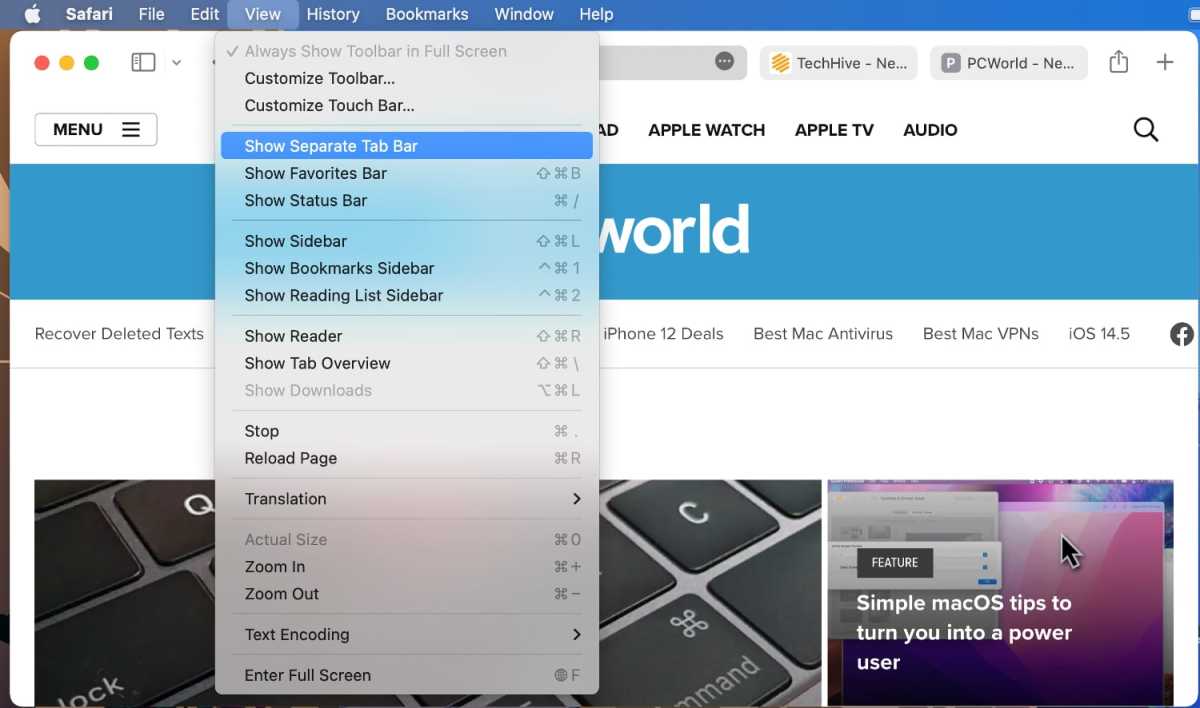
You hve the option to change how tabs are displayed in Safari 15.
Tab groups: The basics
Web research can involve visiting several websites, and sometimes you have a bunch of websites open in tabs, each one relevant to what you’re doing. In Safari 15, you can now save groups of those tabs together as a “tab group” and open that set of tabs whenever you want. For example, if you have a set of websites you like to visit for planning a vacation, you can save that set of sites as a tab group, and open that set when it’s time to plan your next trip.
To create a tab group , set up Safari so the sites you want in the group are open in a tab. Click on the File menu, and then select New Tab Group with x Tabs (the “x” will be the number of tabs currently open).
Another way to create a tab group is to find the Show Sidebar icon on the upper right and click on the down arrow to the right. A pop-up menu will appear and you can select New Tab Group with x Tabs.

To add a tab to a tab group, just open a new tab and go to the site you want. To delete a tab from a tab group, open the tab group, and then close the tab. All the changes are automatically saved to the group.
You can also create an empty tab group , which will have no tabs at the start. Then, any tabs you create are automatically saved in the group. You can create an empty tab group through File > New Empty Tab Group , or by pressing Control+Command+N, or by clicking the down arrow icon to the right of the Show Sidebar icon and selecting New Empty Tab Group.
Tab groups: Organizing and syncing
To open a tab group , click on the down arrow icon to the right of the Show Sidebar icon. In the menu that appears, your tab groups are listed in the middle section. Click on the group that you want to open it.
You can also open a tab group through the Sidebar. Open the Sidebar by clicking the Show Sidebar in the upper left, or through File > Show Sidebar , or by pressing Shift+Command+L. In the Sidebar you’ll find a section called Tab Groups. To open a tab group , click on one and the tabs will open in the main window.
To see thumbnails of the tabs , click on the icon of four squares to the right of the tab group’s name. Or right-click the tab group and select Show Tab Overview .

You can view thumbnails of the tabs in a tab group.
To rename a tab group , click on tab group to select it, then click on the name to trigger the ability to rename it. Or right-click the tab group and select Rename .
To delete a tab group , right-click it and select Delete . Or click on it to select it, and then click on the File menu and select Delete Tab Group .
If you right-click on a tab group, you have a couple more useful functions other than the ones previously mentioned.
- Copy Links: When you select this, A bulleted, hyperlinked list is created on your clipboard. When you paste it, the tab group name appears at the list’s title, and then each bulleted item is the hyperlinked title of each tab.
- At the bottom of right-click menu is a list of the sites in each tab. You can select one and it will load in the main window.
Tab groups sync across devices , so you can use them on your iPhone, iPad, or other Macs.

The Copy Links function creates a hyperlinked bulleted list of your tab group. Here is what the list looks like when pasted into Pages. Clicking on each listing opens that webpage in a browser.
Author: Roman Loyola , Senior Editor, Macworld

Roman is a Macworld Senior Editor with over 30 years of experience covering the tech industry, focusing on the Mac and other products in the Apple ecosystem. He is also the host of the Macworld Podcast. His career started at MacUser, where he received Apple certification as a repair technician (when Apple did that kind of thing). He's also worked for MacAddict, MacLife, and TechTV.
Recent stories by Roman Loyola:
- New Maps, Calendar, and search integrations are coming to Chrome on iOS
- ChatGPT can give you advice on buying a new Mac–the wrong advice
- Apple One: What you need to know about Apple’s services bundle


13 Tips For Getting the Most From the Safari Sidebar
Check out 13 Tips For Getting the Most From the Safari Sidebar at YouTube for closed captioning and more options.
Comments: 2 Responses to “13 Tips For Getting the Most From the Safari Sidebar”
I have to say that I've never gotten offline reading in Safari to work.
I still don’t understand why you can easily edit the Reading List on the iPhone and iPad but not on the Mac. If you want to remove items from the reading list on the Mac you only have the options of removing them on at a time with the context menu or clearing out all of them. This is much better on the other devices and I hope they add the edit feature future versions.
Leave a New Comment Related to "13 Tips For Getting the Most From the Safari Sidebar"
Welcome to macmost, free weekly newsletter.
- MacMost Online Courses

- macOS Sonoma
- Mac Shortcuts
- Mac Numbers
- Mac Keynote
- Final Cut Pro
Keyboard Shortcuts PDF

Connect with MacMost
- Free Email Newsletter
- YouTube Channel
- Follow Gary on Threads
- Follow Gary on Mastodon
- Follow Gary On Bluesky
- MacMost @ Apple News
- iPhone/iPad App
MacMost Sections
- The Practical Guide To Mac Security
- Videos by Category
- Video Archive
- Virus and Malware Information Center
- Protect Yourself From Online Scams
- A Graphical Guide To iCloud
- Free iPhone Ringtones
- Recommended Products
- Printable Mac Keyboard Shortcuts PDF
- macOS System Requirements List
Popular Tutorials
- Why Your MacBook Battery Drains Fast
- Do Not Use Keyboard Covers Or Camera Covers With Your MacBook
- How To Back Up Your Apple Notes
- Using Terminal to Find Large Files and Folders
- Combining Images With Preview
- How To Combine Parts Of Images Using Mac Photos
- 5 Ways To Trim Audio On a Mac
- Learn How To Edit Your Pictures In Mac Photos In 5 Minutes
Information
- About MacMost
- Support MacMost
- Contact MacMost
- MacMost Video List
- MacMost Site Map
- MacMost Site Policies
Copyright © 2006-2024 CleverMedia, Inc. All Rights Reserved.
How-To Geek
How to switch between tabs in safari on iphone.

Your changes have been saved
Email Is sent
Please verify your email address.
You’ve reached your account maximum for followed topics.
After Trying Countless iPad Mini Keyboard Cover Cases, Here’s My Favorite
This all-in-one linux distro isn’t for everyone, but it cured my distro-hopping habit, freedos, the open-source ms-dos, is now 30 years old (and still going), quick links, how to switch tabs with a swipe gesture in safari, how to switch tabs using tabs button in safari.
Switching between the open Safari tabs on your iPhone doesn't have to be a pain. Safari lets you jump or slide between tabs quickly using either a swipe gesture or the Tabs button. We'll show you how to do both.
Related: The Complete Guide to Mastering Tabs in Safari
The Safari interface changed with iOS 15, putting the tab bar at the bottom. You could switch to old Safari , or you could access your tabs by rotating into landscape mode . However, there's a neat way to switch between tabs when the bar is at the bottom while staying in portrait mode.
To get started, launch the Safari browser on your iPhone and open a few sites in different tabs. If you are on the first tab on the list of open tabs, then you'll sell a small part of the tab on the right.
Now, you can perform a left swipe gesture on the tab bar to switch to the next tab.
Similarly, you swipe right to move to the tab on the left to switch to the previous tab if you see a portion of a tab on the left of the tab bar.
Swiping on the tab bar to switch between open Safari tabs can be tedious, especially when you have a lot of open tabs. But with the Tabs button, you can quickly jump from the first tab to the last, or any in between.
Fire up the Safari browser on your iPhone and open some sites in different tabs. Tap the "Tabs" button (two cascading squares) on the right (top or bottom, depending on where you've placed the tab bar).
It'll open a card-style grid of Safari tabs. You can scroll and tap to switch to any tab, and it's quicker than swiping through other open tabs.
That's it! After you're browsing, you can close all Safari tabs at once on iPhone.
Related: How to Close All Safari Tabs at Once on iPhone and iPad
- iPhone & iPad

- Submit Post
- Entertainment
How to organize your browser tabs vertically—and why you should do it
We all like to have our programs set up just the way we like, and browsers are no exception. You can do aesthetic changes, like moving the icons of your favorite extensions for easier reach, or changing the backdrop of new blank tabs.
But you can also revolutionize the way you use the program by changing how tabs propagate during a browsing session. You can rearrange and pin them, of course, but you can also shift their position down to the side of your screen rather than along the top. The option just made its way back to the latest edition of Safari on macOS, but other browsers have vertical tabs, too.
While it might not sound like a major change, it can make a big difference to your browsing experience. You’ll be able to reach tabs on the side more easily and scan them more quickly, (especially if you’re on an ultra-wide monitor ), and web pages will benefit from more vertical space on your screen. It’s an option that’s well worth trying to see if it works for you.
How to activate sidebar tabs on Safari
The most recent version of Safari brings vertical tabs back—the feature was previously available but hasn’t been in recent years. The tabs appear by default in the sidebar, which you can make visible by clicking the Show sidebar icon in the toolbar or by opening the View menu and then choosing Show Sidebar .
[Related: 5 browser extensions that will keep you from drowning in tabs ]
As you browse you’ll see your tabs show up on the left of the screen, as well as any tab groups you’ve saved (just click on any of them to expand them). Click and drag on a tab to change its position on the list, or to drag it to an existing tab group. You can also right-click on a tab title to access all the standard tab options in a pop-up menu, including Close Tab , Duplicate Tab , and Copy Link .
How to get vertical tabs on Chrome
Google Chrome doesn’t support vertical tabs natively, so you’ll need the help of a third-party extension. The perfectly named Vertical Tabs is the best option we found and it won’t cost you anything. Simply download the add-on and then click the orange Vertical Tabs icon in the Chrome toolbar to activate it.
You can drag and drop tabs to reorder them, refresh and close tabs using the buttons to the right, and search your tabs using the box at the top. Right-click on a tab for options such as Pin and Mute this Tab , and click the cog icon at the top to get to the extension options. From there, you can choose which side of the screen the tabs are on, and pick between dark and light themes.
How to bring vertical tabs to Firefox
Just like with Chrome, if you want to get vertical tabs in Firefox, you’ll need the help of a third-party extension. And also just like with Google’s browser, the solution is an add-on called Vertical Tabs , though it’s not the same one we mentioned above. This tool is a fine and free option that’s utterly simple to use. It allows you to display or hide the sidebar by clicking on the Vertical Tabs icon that pops up on the Firefox toolbar once you download the extension. You can also click on the cog icon above the vertical tabs to access the tool’s settings, where you’ll be able to choose a theme if you want to, among other options.
You can change the position of tabs by dragging and dropping them in the sidebar, and close them with a click on the X icons to the right. Right-click on any of the tabs for all the key functions you’re going to need while browsing, such as Reload Tab , Close Tab , and Mute Tab .
How to turn on vertical tabs on Edge
Microsoft has added vertical tabs as a native feature to its Edge browser, so you’ll need no extensions if you use this app to surf the web. To activate them, click the Tab Actions Menu button, which is up in the top left corner of the browser and looks like a square with two small rectangles around it, indicating a browser interface. Then, choose Turn On Vertical Tabs . The tab headers will then make the switch from the top to the left-hand edge of the interface.
As always, you can drag and drop tabs to change their order, close them with a click on the X icons to the right, and bring up a host of other options—from refreshing tabs to bringing back the last tab you closed—by right-clicking on a tab header. Click the Tab Actions Menu again to turn off vertical tabs or to search through them.
How to get vertical tabs on Opera
If Opera is your browser of choice then you’re going to need to install a free extension called, appropriately enough, Vertical Tabs —again, not the same one available for Chrome or Firefox. Once you’ve installed it, you’ll see a new icon on the toolbar on the left, which looks like four horizontal lines on top of each other. Click on it to show or hide the vertical tab list. You can also click the pin icon on the actual vertical tabs list so that it remains visible.
[Related: Twelve ways to make your new browser tabs more exciting ]
You can reorder tabs by dragging and dropping them, and if you hover over a tab title you can close it by clicking the X on the right. Around the side of the vertical tabs panel you’ll see buttons for pinning and grouping tabs, searching through tabs, and all the other key functions you’re going to need.
The post How to organize your browser tabs vertically—and why you should do it appeared first on Popular Science .
How to Quickly Access Sites in Safari on a Mac Using Pinned Tabs

Your changes have been saved
Email Is sent
Please verify your email address.
You’ve reached your account maximum for followed topics.
When Does Facebook Messenger Notify Others About Screenshots?
Figma can use your content to train its ai: how to opt out, why i prefer apple’s magic mouse over any other brand for my mac.
Safari, the default web browser across all Apple devices, is a pretty decent yet underrated browser. Since its release in 2003, Apple has continuously updated Safari with efficiency in mind to ensure that users have the best internet experience.
One of the most basic customizations that you can do in Safari on a Mac to make browsing more efficient is pinning the websites you frequently visit. Read on to learn how to create and manage your pins.
What Is a Pinned Tab?
Pinned tabs or sites are visual shortcuts of websites that you frequently visit or use. Pinning tabs allow you to save time from manually opening each site. It also prevents you from accidentally closing them.
Pinned tabs stay in place even when you close and relaunch Safari or open a new window. This may come in handy when you work across several windows and need to access specific sites quickly.
When you click on any link from the pinned tab, the website will open in another tab, ensuring that your pinned tab will stay in place. Another cool thing about pinned tabs is that they refresh on the background, which means they’re always up to date.
How to Create Pinned Tabs in macOS
Before trying this feature, know that it only works in Safari running on OS X El Capitan and later.
Pinning tabs in Safari is pretty straightforward. Just open a website you frequently visit, then drag the tab to the leftmost side of the tab bar and release your hold when the tab shrinks, displaying only the website’s initial or icon.
Alternatively, you can Control-click or two-finger-pad on the tab, then choose Pin Tab .
How to Manage Pinned Tabs
Now that you’ve created your pins, manage them by doing the following:
- Remove Pinned Tabs: Unpin a website by clicking and holding the pinned tab and dragging it to the right side of the tab bar. Another option is to Control-click or two-finger-tap the pinned tab and choose Unpin Tab .
- Duplicate Tabs: If you want to open the same pinned website in another tab, Control-click or two-finger-tap the pinned tab and click Duplicate Tab . The pinned site will open in a new tab.
Related: Essential Safari Tips and Tricks for Mac Users
An Alternative to Pinned Tabs
Suppose you need some organization in Safari but don’t like your tab bar to be cluttered. Well, you also have the option to bookmark websites instead of pinning them.
To bookmark a site, just click the Share button (the box icon with an upward pointing arrow) then click Add Bookmark . Bookmarks are also accessible like pinned tabs. Just click the Sidebar icon on your toolbar to access your bookmarked sites.
Compared to pinning tabs, bookmarks allow you to organize sites into folders, which can come in handy if you use several websites for specific tasks, workflows, and projects. Saving and bookmarking multiple tabs at a time is also very easy with Safari.
Your Favorite Websites Are a Tap Away
If you use Safari to check on specific sites on a daily basis, pinning them is a great way to instantly access them whenever you need to. While it seems like an unnecessary perk, having a less cluttered tab bar can actually do wonders for your workflow.
- Safari Browser
Looks like no one’s replied in a while. To start the conversation again, simply ask a new question.
How to Permanently Disable Sidebar on Safari Catalina
Has anyone been able to find a solution to the constant appearance of the left sidebar on the mac laptop? It's 2020 and there have been so many complaints about this, that you'd think by now there would be a way to resolve it! Everytime I open a new tab, the sidebar returns. Please do not tell me to go to View and Hide the Sidebar. I'd like to PERMANENTLY disable this feature. Thanks!!
MacBook Pro 13″, 10.15
Posted on Jun 11, 2020 6:49 AM
Posted on Jun 21, 2020 6:58 AM
My question: How to Permanently DISABLE the Sidebar on Safari Catalina. I did not ask to REMOVE it from the toolbar. I asked to disable it, while using Safari.
Everytime I open a new tab in Safari, the sidebar returns. Please do not tell me to go to View and Hide the Sidebar. I'm not asking that either. I'm like to PERMANENTLY disable the sidebar feature so when I open a new tab, I WILL NOT SEE THE SIDEBAR.
TO BE CLEAR, when using Safari, I want to open pages in full screen. I do not want the side bar to open each time I use my Safari Browser. Not sure how many different ways I can ask this…but hopefully the question is clear. Thanks!!
Similar questions
- sidebar on left How do I get rid of the annoying left sidebar on my big Mac...if I don't know if I'm using Safari or not? 278 5
- How do I show my menu bar/toolbar permanently in full screen? I don't know that this is a Mac OS Catalina problem, as this started before the last update, but a couple of months ago the menu bar at the top of my screen would vanish when in full screen. Previously it was there permanently, which is my preference. I followed help topics and went to System Preferences/General and have checked and unchecked the "Automatically hide and show the menu bar", but neither makes the menu bar permanent in full screen. Is anyone else familiar with this problem? I checked community topics and didn't see anything recent/helpful, but my apologies if I missed something. 563 4
- How Can I Stop the Menu Bar from Hiding? The menu bar automatically hides during full-screen internet browsing, and sometimes in desktop mode- disrupting my workflow almost every time I try to swap between tabs and tab groups (frequent in legal research). As an attempt to solve the problem, I've unchecked both boxes to "Automatically hide the menu bar" on the desktop and in full-screen mode and restarted the computer. Still, the auto-hiding behavior continues. I use a 13" Macbook Air 2020 with macOS Monterey. All assistance is appreciated! 1355 1
Loading page content
Page content loaded
Jun 21, 2020 6:58 AM in response to MoonJ.
Jun 15, 2020 5:09 AM in response to kennieken
Hi kennieken,
I understand you want to remove the Sidebar and I want to help.
Is it that you would like to remove it from the toolbar? You cannot remove the feature from the app, but if you remove it from your toolbar and do not enable Sidebar you will not see it.
If you're trying to remove the Sidebar option from the toolbar, follow these steps:
- Change the items in the toolbar: Choose View > Customize Toolbar, then add, remove, and rearrange toolbar items by dragging them.
Customize the Safari browser window on Mac - Apple Support
Let me know if customizing the toolbar to remove Sidebar helps.
Thanks for using the Apple Support Communities.
Jun 21, 2020 11:08 AM in response to kennieken
As mentioned above, you cannot remove a feature of an app from an app. The sidebar that you are referencing, would it be the Reading List as shown on the left in the image below? Keep a Reading List in Safari on Mac

If you hide the Reading List then open a new tab, does that no longer show the sidebar? If that isn't the sidebar you are talking about, can you please describe what you are seeing when you look at the sidebar?
Safari User Guide
- Get started
- Go to a website
- Bookmark web pages to revisit
- See your favourite websites
- Use tabs for web pages
- Import bookmarks and passwords
- Pay with Apple Pay
- Autofill credit card info
- View links from friends
- Keep a Reading List
- Hide ads when reading
- Translate a web page
- Download items from the web
- Add passes to Wallet
- Save part or all of a web page
- Print or create a PDF of a web page
- Interact with text in a picture
- Change your home page
- Customise a start page
- Create a profile
- Block pop-ups
- Make Safari your default web browser
- Hide your email address
- Manage cookies
- Clear your browsing history
- Browse privately
- Prevent cross-site tracking
- See who tried to track you
- Change Safari settings
- Keyboard and other shortcuts
Edit and customise Tab Groups in Safari on Mac
You can choose the tabs to include in each Tab Group, arrange the tabs, choose a background for the start page of each Tab Group and share Tab Groups across your Apple devices.
Open Safari for me
Edit a Tab Group
Arrange the tabs in a Tab Group: In the tab bar, drag a tab before or after another tab.
Arrange Tab Groups: In the sidebar, drag a Tab Group before or after another Tab Group.
Delete a Tab Group: In the sidebar, Control-click a Tab Group, then choose Delete.
Rename a Tab Group: In the sidebar, Control-click a Tab Group, choose Rename, enter a name, then press Return.
Choose a background for the start page of a Tab Group
Choose Bookmarks > Show Start Page.
Choose a background for the start page of the Tab Group.
You can also drag a photo onto the start page.
Click in the Safari window.
You can choose a different background for the start page of each Tab Group.
Keep Tab Groups updated across your Apple devices
Sign in to your other Apple devices with the same Apple ID as on your Mac.
Set up iCloud for Safari on all your devices .
Turn on two-factor authentication on all your Apple devices.
See the Apple Support article Two-factor authentication for Apple ID .
Side Space - Vertical Tab Manager
Your vertical tabs manager located in the side panel.
Your vertical tabs manager located in the side panel. Alternative to Arc's Sidebar/Edge's Vertical Tabs. It allows you to have more control over your web browsing experience by effectively managing multiple tabs at once. 🚀 How do vertical tabs work? Enabling the vertical tabs setting moves your open tabs from the top of your browser window (above the address bar) to the left side of the window. This allows the tabs to be displayed vertically, stacked one on top of the other, instead of horizontally. ✨ Features - ⚡️ Manage tabs and tab groups efficiently with a vertical tabs panel. - 🗂️ To save, restore, and reorganize tabs, including tab groups, is now available. - 🔄 The Vertical Tabs Panel displays your open tabs in a mirrored view. - 🔍 Efficiently search multiple tabs using fuzzy search. - 🧹 To save memory, you can suspend open tabs. - ☁️ Enable cross-browser cloud synchronization with a single login. - 🌛 Dark Mode Support. - 💾 Space Backup Solution - 📑 Save your session as a JSON file - ☁️ Cloud sync by login - ✨ AI-powered Tab Grouping 👍 The advantages of vertical tabs Vertical tabs are an effective solution for avoiding clutter in your browser window and maximizing your on-screen space. Additionally, they enhance tab visibility for easier identification. PS: Side Space is a futuristic vertical tab manager that can only be used with Chrome version 114 or above.
4.5 out of 5 15 ratings Google doesn't verify reviews. Learn more about results and reviews.
Bob Kats Jun 24, 2024
I like it. Seems to do what it's supposed to, why I installed it for the most part. But then it says create and account, which I did, well thought I did, then thought I didn't and then realized I did - The Sign up page needs better messaging. Anyway signed up and verified via email (I think) but I cannot login at all. go to login put in my email and password and click sign-in button and nothing. Is something supposed to happen, b/c nothing. I realize beta, and that's why it's a 3 star for now... Show more
Jeremy Gilmore May 8, 2024
Am I missing something or is there a way to put the side bar on the left side instead of the right? I see this in the product images, but yeah... otherwise exactly what I was looking for. I do wonder how this will continue to stand out when Chrome evvvvvvennnntuually brings us vertical tabs like most other browsers now. Happy to have this option today though :) EDIT: The option to put it on the left is in chrome settings -> Appearance --> Sidebar
Thomas Quinlan Mar 31, 2024
This works like a charm. I installed it, clicked "Group by AI", and seconds later I had a list of various tab groups all on the right side of my browser (you can choose left in Chrome preferences) just like I wanted. While the AI grouping isn't 100%, that's down to the AI and not the developers. It works really well, looks good, and even managed to find ten duplicate tabs (!) that I had open that it offered to close for me. (I took it up on the offer.) It didn't touch my pinned tabs and even ... Show more
- Version 0.2.6
- Updated June 18, 2024
- Report a concern
- Size 1.2MiB
- Languages 2 languages English , 中文 (简体)
- Developer Website Email [email protected]
- Non-trader This developer has not identified itself as a trader. For consumers in the European Union, please note that consumer rights do not apply to contracts between you and this developer.
This developer declares that your data is
- Not being sold to third parties, outside of the approved use cases
- Not being used or transferred for purposes that are unrelated to the item's core functionality
- Not being used or transferred to determine creditworthiness or for lending purposes
For help with questions, suggestions, or problems, visit the developer's support site
You might also like…
Vertical Tabs in Side Panel
Display and manage tabs vertically in the browser sidebar.
Vertical Tabs
Vertical tab manager in side panel
Tab Shelf - Side panel vertical tabs
Vertical tab management from your side panel with support for tab groups, multiple windows, and much more.
SideTab Pro - Vertical Tabs
Vertical tabs for chrome in side panel

How to Group Tabs in Chrome, Edge, Safari, and Firefox
Quick links, how to group tabs in google chrome, how to group tabs in edge, how to group tabs in firefox, how to group tabs in safari.
- Group tabs in Chrome by right-clicking any tab, selecting Add tab to new group , and naming/color-coding it for easy management.
- Edge allows tab grouping by right-clicking a tab or using the Tab actions menu for suggested groups.
- Firefox lacks built-in tab grouping, but the Simple Tab Groups add-on helps create, hide, and manage tab groups efficiently.
- Safari keeps it simple with a dropdown menu, followed by creating a new group.
If you're a tab hoarder, tab groups are the best way to organize your browsing experience, so it's time to learn how to group tabs in the most popular browsers: Chrome, Safari, Edge, and Firefox.
Grouping tabs in Google Chrome is quite easy. To do so, right-click on any tab you want to add to a tab group. Select Add tab to new group and then name and color code your tab group. This helps you manage tab groups when you have multiple groups open.
To add more tabs to an existing group, drag and drop them near the tab group. Alternatively, right-click the tab you want to add to the group, click on Add tab to group , hover your mouse over it, and select the tab group where you want to add it.
If you use the same set of tabs frequently (perhaps for work), you can save the tab group in Chrome by right-clicking the tab group name in the tab bar and turning Save group on. Essentially, it is a bookmark of different tabs that you can access with a single click, and the saved tab group appears on your bookmark bar.
Like Chrome, Edge also lets you group tabs by right-clicking any tab and selecting Add tab to new group . In the same way, you can drag and drop tabs (once you've created a group) to add or remove them from the group.
However, Edge also offers another simpler way to group tabs. Click on the Tab actions menu icon (in the top-left corner) and select Organize Tabs . Edge then shows suggested tab groups, giving each of them a suitable name. If you need to change the tab groups, you can drag them into/out of the group. Then, click Group tabs , and voilà, your tabs are organized.
If you can't see the Tab actions menu, go to edge://settings/appearance, scroll down to Customize Toolbar, and turn on the Show tab actions menu .
Unfortunately, Firefox does not have a built-in feature for grouping tabs, so you'll have to resort to add-ons to manage multiple tabs in Firefox . Though there are several add-ons you can try, Simple Tab Groups is quite a popular and handy one.
Download: Simple Tab Groups for Firefox (Free)
Once you've downloaded the add-on, right-click any tab, select Move tab to the group , and then Create new group . Name the tab group and move all related tabs to the group.
Simple Tab Groups hides the grouped tabs from your window to declutter the screen. To access tab groups, click the extension icon and select Simple Tab Groups . From here, you can create new tab groups or click any existing tab group to open it. Right-clicking the group name shows more options, like discarding, exporting, or opening tabs in a new window.
You can also create a new group by clicking the extension icon , selecting Simple Tab Groups , and choosing Create new group .
Pin the extension to the toolbar to open tab groups quickly.
To create a tab group in Safari , follow these steps.
- Click the down icon (next to the sidebar icon) and select New Empty Tab Group if you don't want to add any tab to the group for now.
- If you already have tabs open, you can select New Tab Group with X Tabs to add all the open tabs to the newly-created group.
- Once you've created a tab group, Safari lets you rename it to your liking.
- You can also access the option to create a tab group by clicking on File .
Once you've organized all the tabs into groups, click the down arrow (beside the sidebar icon) to see all the different tab groups and select the one you want to open.


IMAGES
VIDEO
COMMENTS
Simply download the add-on and then click the orange Vertical Tabs icon in the Chrome toolbar to activate it. You can drag and drop tabs to reorder them, refresh and close tabs using the buttons ...
In the Safari app on your Mac, use Tabs preferences to choose how pages, links, and tabs work in Safari windows. To change these preferences, choose Safari > Preferences, then click Tabs. Keep tabs in a separate tab bar, or move them into the toolbar. Separate: Tabs remain in the tab bar, under the toolbar. Compact: Tabs move up to the toolbar.
Here's how to split screen two Safari tabs between your Mac: 1. Open the first Safari tab that you want to view in Split View. 2. Press Command + F3 or Control +F3 to bring up Mission Control ...
Click the down arrow in the toolbar. (It's next to the button that opens the sidebar.) Pick New Empty Tab Group. Name your tab group, then press enter. Right-click a tab you want to add to the ...
FireFox has several extensions that support vertical tabs. I used the "Tree Style Tab" until I switched to Safari's tab groups. The "Tree Style Tab" allows you to organize the tabs hierarchically in the sidebar, thus simulating the grouping capabilities other browsers.
https://macmost.com/e-2537 Safari 15 includes major changes to how tabs look and work. You can now choose between two different ways tabs look at the top of ...
In the Safari app on your Mac, click a tab to select it, then do one of the following: Command-click other tabs to select them. Shift-click another tab to select all tabs in between. Do one of the following: Drag the tabs to a new position in the tab bar, sidebar, or another window. Control-click the tabs, then choose an action from the pop-up ...
Here's how tabs work in Safari 15 and how to make tab groups. New tab UI. Safari's toolbar can take on the color used by a website. Safari's toolbar can take on the color used by a website.
Open a webpage in a new tab from the bookmarks sidebar. In the Safari app on your Mac, do any of the following: Control-click a bookmark, then choose Open in New Tab from the shortcut menu. Control-click a bookmarks folder, then choose Open in New Tabs. To open the bookmarks sidebar, click the Sidebar button in the toolbar, then click Bookmarks.
Open a website in a new window and make it active: Command+Option+Shift+Click on a link. Select one of the first nine tabs: Command+1 through Command+9. Close all tabs but one: Option+click the close (X) button on the tab you want to keep open. Reopen the last tab (s) or window (s): Command+Shift+T.
Now, here are 30 tricks to help you have a better experience when using Safari. 1. Navigate Tab Bar. (Credit: Lance Whitney / Apple) The jump to iOS 15 moved Safari's address bar to the bottom of ...
Notice the Keyboard Shortcut is Shift, Command, L. This will both show the Sidebar and the same command will Hide the Sidebar. But you could also use two other shortcuts right underneath. Show Bookmarks Sidebar and Show Reading List Sidebar. These will show the sidebar and switch it to one of these two modes.
1. If you have two safari windows open ( command + n) then you can press long on the green button on the top left of one of the two windows and the following window will appear: Then you can choose where you want this page on your screen, left or right, and then on the other side where you selected you can choose the other safari pages.
In Safari settings, swipe upward until you locate the "Tabs" section. Tap the switch beside "Show Tab Bar" to turn it off. If you previously turned off the tab bar and want it back, tap the "Show Tab Bar" switch instead to turn it back on here. After that, launch Safari. You'll notice that the tab toolbar is now hidden.
If yes, we recommend that you check out the steps under the "Make adjustments to multitasking windows" section in the article below. Use multitasking on your iPad. Please keep us posted. Take care! How to turn off left sidebar appearing in ios ver.15.3.1. .
Fire up the Safari browser on your iPhone and open some sites in different tabs. Tap the "Tabs" button (two cascading squares) on the right (top or bottom, depending on where you've placed the tab bar). It'll open a card-style grid of Safari tabs. You can scroll and tap to switch to any tab, and it's quicker than swiping through other open tabs.
Pin a tab at the front of a Tab Group. You can customize your Tab Groups with pinned tabs in each group. The pinned tab stays pinned to the left side of the tab bar. Touch and hold the tab you want to pin. In the menu that appears, tap Pin Tab. To unpin the tab, touch and hold it, then tap Unpin Tab.
Safari With the latest Apple software update, Safari only appears on part of the iPad screen and some useless info appears on the left hand side, like tabs, Shared with you, bookmarks etc. I cannot get rid of that info and get Safari to fill the whole screen. Just makes Safari useless for me. Everything seems to get less intuitive and more cumbersome with each update.
Simply download the add-on and then click the orange Vertical Tabs icon in the Chrome toolbar to activate it. You can drag and drop tabs to reorder them, refresh and close tabs using the buttons to the right, and search your tabs using the box at the top. Right-click on a tab for options such as Pin and Mute this Tab, and click the cog icon at ...
Some employees in my office get confused by tabs on the top of Safari. It is measurably affecting productivity. I need to get the tabs on the left side of the screen with a title next to each tab. We currently use Safari because it has adblock ("Ka-Block!"). We cannot deploy any solution in this company if it results in my employees seeing ads.
Pinning tabs in Safari is pretty straightforward. Just open a website you frequently visit, then drag the tab to the leftmost side of the tab bar and release your hold when the tab shrinks, displaying only the website's initial or icon. Alternatively, you can Control-click or two-finger-pad on the tab, then choose Pin Tab .
Change the items in the toolbar: Choose View > Customize Toolbar, then add, remove, and rearrange toolbar items by dragging them. Customize the Safari browser window on Mac - Apple Support. Let me know if customizing the toolbar to remove Sidebar helps. Thanks for using the Apple Support Communities. Rigo_O86.
In the Safari app on your Mac, do any of the following:. Delete a tab from a Tab Group: Open the Tab Group, place the pointer over the tab in the tab bar, then click the Close button on the left side of the tab. Arrange the tabs in a Tab Group: In the tab bar, drag a tab before or after another tab. Arrange Tab Groups: In the sidebar, drag a Tab Group before or after another Tab Group.
Features - ⚡️ Manage tabs and tab groups efficiently with a vertical tabs panel. - 🗂️ To save, restore, and reorganize tabs, including tab groups, is now available. - 🔄 The Vertical Tabs Panel displays your open tabs in a mirrored view. - 🔍 Efficiently search multiple tabs using fuzzy search. - 🧹 To save memory, you can ...
Download: Simple Tab Groups for Firefox (Free) Once you've downloaded the add-on, right-click any tab, select Move tab to the group, and then Create new group.Name the tab group and move all ...